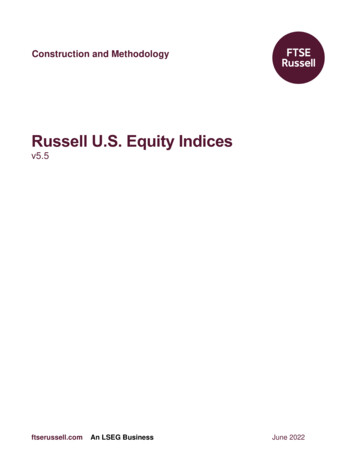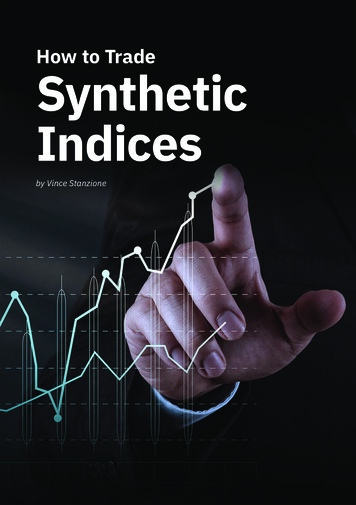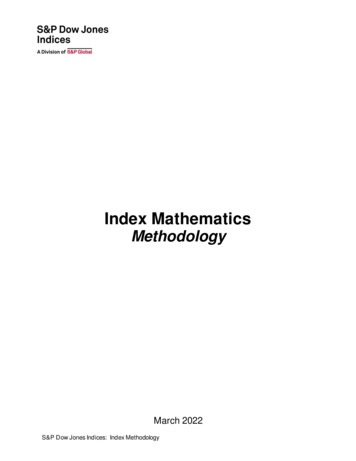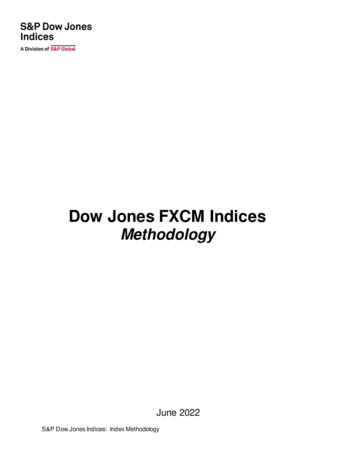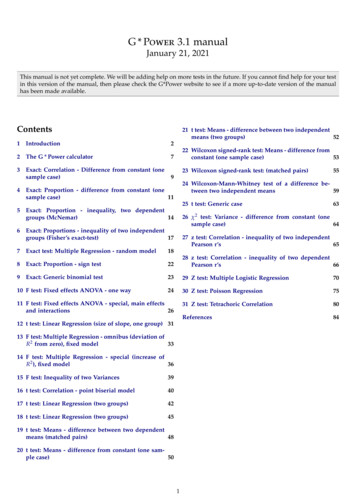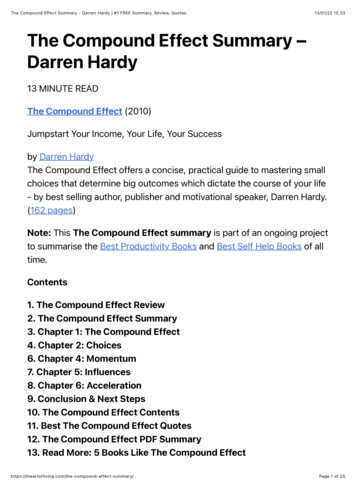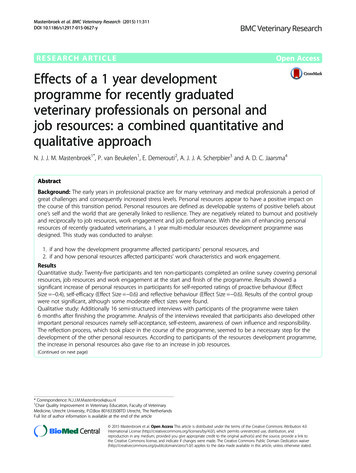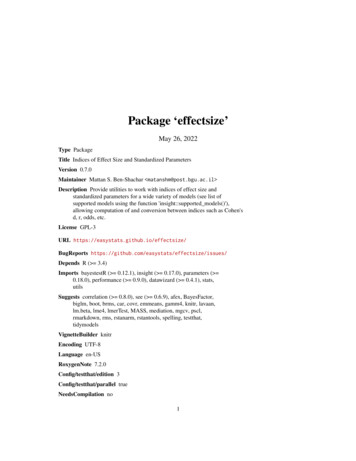
Transcription
Package ‘effectsize’May 26, 2022Type PackageTitle Indices of Effect Size and Standardized ParametersVersion 0.7.0Maintainer Mattan S. Ben-Shachar matanshm@post.bgu.ac.il Description Provide utilities to work with indices of effect size andstandardized parameters for a wide variety of models (see list ofsupported models using the function 'insight::supported models()'),allowing computation of and conversion between indices such as Cohen'sd, r, odds, etc.License GPL-3URL https://easystats.github.io/effectsize/BugReports ends R ( 3.4)Imports bayestestR ( 0.12.1), insight ( 0.17.0), parameters ( 0.18.0), performance ( 0.9.0), datawizard ( 0.4.1), stats,utilsSuggests correlation ( 0.8.0), see ( 0.6.9), afex, BayesFactor,biglm, boot, brms, car, covr, emmeans, gamm4, knitr, lavaan,lm.beta, lme4, lmerTest, MASS, mediation, mgcv, pscl,rmarkdown, rms, rstanarm, rstantools, spelling, testthat,tidymodelsVignetteBuilder knitrEncoding UTF-8Language en-USRoxygenNote 7.2.0Config/testthat/edition 3Config/testthat/parallel trueNeedsCompilation no1
R topics documented:2Author Mattan S. Ben-Shachar [aut, cre]( https://orcid.org/0000-0002-4287-4801 , @mattansb),Dominique Makowski [aut] ( https://orcid.org/0000-0001-5375-9967 ,@Dom Makowski),Daniel Lüdecke [aut] ( https://orcid.org/0000-0002-8895-3206 ,@strengejacke),Indrajeet Patil [aut] ( https://orcid.org/0000-0003-1995-6531 ,@patilindrajeets),Brenton M. Wiernik [aut] ( https://orcid.org/0000-0001-9560-6336 ,@bmwiernik),Ken Kelley [ctb],David Stanley [ctb],Jessica Burnett [rev] ( https://orcid.org/0000-0002-0896-5099 ),Johannes Karreth [rev] ( https://orcid.org/0000-0003-4586-7153 )Repository CRANDate/Publication 2022-05-26 13:20:02 UTCR topics documented:chisq to phi . . . . . . . . . . .cles . . . . . . . . . . . . . . .cohens d . . . . . . . . . . . .d to cles . . . . . . . . . . . .d to r . . . . . . . . . . . . . .effectsize.BFBayesFactor . . . .effectsize API . . . . . . . . . .effectsize CIs . . . . . . . . . .effectsize deprecated . . . . . .equivalence test.effectsize tableeta2 to f2 . . . . . . . . . . . .eta squared . . . . . . . . . . .format standardize . . . . . . .F to eta2 . . . . . . . . . . . .hardlyworking . . . . . . . . . .interpret . . . . . . . . . . . . .interpret bf . . . . . . . . . . .interpret cohens d . . . . . . .interpret cohens g . . . . . . .interpret direction . . . . . . . .interpret ess . . . . . . . . . . .interpret gfi . . . . . . . . . . .interpret icc . . . . . . . . . . .interpret kendalls w . . . . . .interpret oddsratio . . . . . . .interpret omega squared . . . .interpret p . . . . . . . . . . . .interpret pd . . . . . . . . . . 5253
chisq to phi3interpret r . . . . . .interpret r2 . . . . .interpret rope . . . .interpret vif . . . . .is effectsize name .oddsratio to riskratioodds to probs . . . .phi . . . . . . . . . .plot.effectsize table .rank biserial . . . .rules . . . . . . . . .sd pooled . . . . . .t to d . . . . . . . .Indexchisq to phi.5456575859596061666771727377Conversion Chi-Squared to Phi or Cramer’s VDescriptionConvert between Chi square (χ2 ), Cramer’s V, phi (φ), Cohen’s w, normalized Chi (χ) and Pearson’sC for contingency tables or goodness of fit.Usagechisq to phi(chisq,n,nrow 2,ncol 2,ci 0.95,alternative "greater",adjust FALSE,.)chisq to cohens w(chisq,n,nrow,ncol,ci 0.95,alternative "greater",.)chisq to cramers v(
4chisq to phi)chisq,n,nrow,ncol,ci 0.95,alternative "greater",adjust FALSE,.chisq to normalized(chisq,n,nrow,ncol,p,ci 0.95,alternative "greater",.)chisq to pearsons c(chisq,n,nrow,ncol,ci 0.95,alternative "greater",.)phi to chisq(phi, n, .)ArgumentschisqThe Chi-squared statistic.nTotal sample size.nrow, ncolThe number of rows/columns in the contingency table.ciConfidence Interval (CI) levelalternativea character string specifying the alternative hypothesis; Controls the type ofCI returned: "greater" (default) or "less" (one-sided CI), or "two.sided"(default, two-sided CI). Partial matching is allowed (e.g., "g", "l", "two".).See One-Sided CIs in effectsize CIs.adjustShould the effect size be bias-corrected? Defaults to FALSE.Arguments passed to or from other methods.pVector of expected values. See stats::chisq.test().phiThe Phi statistic.
chisq to phi5DetailsThese functions use the following formulae:φ pχ2 /npCramer0 sV φ/ min(nrow, ncol) 1P earson0 sC pχ2 /(χ2 n)rχN ormalized w q1 qWhere q is the smallest of the expected probabilities.For adjusted versions of phi and V, see Bergsma, 2013.ValueA data frame with the effect size(s), and confidence interval(s). See cramers v().Confidence (Compatibility) Intervals (CIs)Unless stated otherwise, confidence (compatibility) intervals (CIs) are estimated using the noncentrality parameter method (also called the "pivot method"). This method finds the noncentralityparameter ("ncp") of a noncentral t, F, or χ2 distribution that places the observed t, F, or χ2 teststatistic at the desired probability point of the distribution. For example, if the observed t statistic is2.0, with 50 degrees of freedom, for which cumulative noncentral t distribution is t 2.0 the .025quantile (answer: the noncentral t distribution with ncp .04)? After estimating these confidencebounds on the ncp, they are converted into the effect size metric to obtain a confidence interval forthe effect size (Steiger, 2004).For additional details on estimation and troubleshooting, see effectsize CIs.CIs and Significance Tests"Confidence intervals on measures of effect size convey all the information in a hypothesis test,and more." (Steiger, 2004). Confidence (compatibility) intervals and p values are complementarysummaries of parameter uncertainty given the observed data. A dichotomous hypothesis test couldbe performed with either a CI or a p value. The 100 (1 - α)% confidence interval contains all of theparameter values for which p α for the current data and model. For example, a 95% confidenceinterval contains all of the values for which p .05.Note that a confidence interval including 0 does not indicate that the null (no effect) is true. Rather,it suggests that the observed data together with the model and its assumptions combined do not provided clear evidence against a parameter value of 0 (same as with any other value in the interval),
6chisq to phiwith the level of this evidence defined by the chosen α level (Rafi & Greenland, 2020; Schweder& Hjort, 2016; Xie & Singh, 2013). To infer no effect, additional judgments about what parametervalues are "close enough" to 0 to be negligible are needed ("equivalence testing"; Bauer & Kiesser,1996).References Cumming, G., & Finch, S. (2001). A primer on the understanding, use, and calculation ofconfidence intervals that are based on central and noncentral distributions. Educational andPsychological Measurement, 61(4), 532-574. Bergsma, W. (2013). A bias-correction for Cramer’s V and Tschuprow’s T. Journal of theKorean Statistical Society, 42(3), 323-328. Johnston, J. E., Berry, K. J., & Mielke Jr, P. W. (2006). Measures of effect size for chi-squaredand likelihood-ratio goodness-of-fit tests. Perceptual and motor skills, 103(2), 412-414. Rosenberg, M. S. (2010). A generalized formula for converting chi-square tests to effect sizesfor meta-analysis. PloS one, 5(4), e10059.See AlsoOther effect size from test statistic: F to eta2(), t to d()Examplescontingency table - as.table(rbind(c(762, 327, 468), c(484, 239, 477), c(484, 239, 477)))# chisq.test(contingency table)# # Pearson's Chi-squared test# # data: contingency table# X-squared 41.234, df 4, p-value 2.405e-08chisq to cohens w(41.234,n sum(contingency table),nrow nrow(contingency table),ncol ncol(contingency table))Smoking ASD - as.table(c(ASD 17, ASP 11, TD 640))# chisq.test(Smoking ASD, p c(0.015, 0.010, 0.975))# # Chi-squared test for given probabilities# # data: Smoking ASD# X-squared 7.8521, df 2, p-value 0.01972chisq to normalized(
cles7)7.8521,n sum(Smoking ASD),nrow 1,ncol 3,p c(0.015, 0.010, 0.975)clesEstimate Common Language Effect Sizes (CLES)Descriptioncohens u3(), p superiority(), and p overlap() give only one of the CLESs.Usagecles(x,y NULL,data NULL,mu 0,ci 0.95,alternative "two.sided",parametric TRUE,verbose TRUE,iterations 200,.)common language(x,y NULL,data NULL,mu 0,ci 0.95,alternative "two.sided",parametric TRUE,verbose TRUE,iterations 200,.)cohens u3(.)p superiority(.)p overlap(.)
8clesArgumentsxA formula, a numeric vector, or a character name of one in data.yA numeric vector, a grouping (character / factor) vector, a or a character nameof one in data. Ignored if x is a formula.dataAn optional data frame containing the variables.mua number indicating the true value of the mean (or difference in means if youare performing a two sample test).ciConfidence Interval (CI) levelalternativea character string specifying the alternative hypothesis; Controls the type of CIreturned: "two.sided" (default, two-sided CI), "greater" or "less" (onesided CI). Partial matching is allowed (e.g., "g", "l", "two".). See One-SidedCIs in effectsize CIs.parametricUse parametric estimation (see cohens d()) or non-parametric estimation (seerank biserial()).verboseToggle warnings and messages on or off.iterationsThe number of bootstrap replicates for computing confidence intervals. Onlyapplies when ci is not NULL and parametric FALSE.Arguments passed to or from other methods. When x is a formula, these can besubset and na.action.DetailsThese measures of effect size present group differences in probabilistic terms: Probability of superiority is the probability that, when sampling an observation from eachof the groups at random, that the observation from the second group will be larger than thesample from the first group. Cohen’s U3 is the proportion of the second group that is smaller than the median of the firstgroup. Overlap (OVL) is the proportional overlap between the distributions. (When parametric FALSE, bayestestR::overlap() is used.)For unequal group sizes, it is recommended to use the non-parametric based CLES (parametric FALSE).ValueA data frame containing the common language effect sizes (and optionally their CIs).Confidence Intervals (CIs)For parametric CLES, the CIs are transformed CIs for Cohen’s d (d to cles()). For non-parametric(parametric FALSE) CLES, the CI of Pr(superiority) is a transformed CI of the rank-biserial correlation (rb to cles()), while for Cohen’s U3 and the Overlap coefficient the confidence intervalsare bootstrapped (requires the boot package).
cohens d9References Cohen, J. (1977). Statistical power analysis for the behavioral sciences. New York: Routledge. Reiser, B., & Faraggi, D. (1999). Confidence intervals for the overlapping coefficient: thenormal equal variance case. Journal of the Royal Statistical Society, 48(3), 413-418. Ruscio, J. (2008). A probability-based measure of effect size: robustness to base rates andother factors. Psychological methods, 13(1), 19–30.See Alsod to cles() sd pooled()Other effect size indices: cohens d(), effectsize.BFBayesFactor(), eta squared(), phi(),rank biserial()Examplescles(mpg am, data mtcars)set.seed(4)cles(mpg am, data mtcars, parametric FALSE)## Not run:## Individual CLESp superiority(extra group, data sleep)cohens u3(extra group, data sleep, parametric FALSE)p overlap(extra group, data sleep)## End(Not run)cohens dEffect size for differencesDescriptionCompute effect size indices for standardized differences: Cohen’s d, Hedges’ g and Glass’s delta( ). (This function returns the population estimate.)Both Cohen’s d and Hedges’ g are the estimated the standardized difference between the meansof two populations. Hedges’ g provides a bias correction (using the exact method) to Cohen’s dfor small sample sizes. For sample sizes 20, the results for both statistics are roughly equivalent.Glass’s delta is appropriate when the standard deviations are significantly different between thepopulations, as it uses only the second group’s standard deviation.
10cohens dUsagecohens d(x,y NULL,data NULL,pooled sd TRUE,mu 0,paired FALSE,ci 0.95,alternative "two.sided",verbose TRUE,.)hedges g(x,y NULL,data NULL,pooled sd TRUE,mu 0,paired FALSE,ci 0.95,alternative "two.sided",verbose TRUE,.)glass delta(x,y NULL,data NULL,mu 0,ci 0.95,alternative "two.sided",verbose TRUE,.)ArgumentsxA formula, a numeric vector, or a character name of one in data.yA numeric vector, a grouping (character / factor) vector, a or a character nameof one in data. Ignored if x is a formula.dataAn optional data frame containing the variables.pooled sdIf TRUE (default), a sd pooled() is used (assuming equal variance). Else themean SD from both groups is used instead.
cohens d11mua number indicating the true value of the mean (or difference in means if youare performing a two sample test).pairedIf TRUE, the values of x and y are considered as paired. This produces an effectsize that is equivalent to the one-sample effect size on x - y.ciConfidence Interval (CI) levelalternativea character string specifying the alternative hypothesis; Controls the type of CIreturned: "two.sided" (default, two-sided CI), "greater" or "less" (onesided CI). Partial matching is allowed (e.g., "g", "l", "two".). See One-SidedCIs in effectsize CIs.verboseToggle warnings and messages on or off.Arguments passed to or from other methods. When x is a formula, these can besubset and na.action.DetailsSet pooled sd FALSE for effect sizes that are to accompany a Welch’s t-test (Delacre et al, 2021).ValueA data frame with the effect size ( Cohens d, Hedges g, Glass delta) and their CIs (CI low andCI high).Confidence (Compatibility) Intervals (CIs)Unless stated otherwise, confidence (compatibility) intervals (CIs) are estimated using the noncentrality parameter method (also called the "pivot method"). This method finds the noncentralityparameter ("ncp") of a noncentral t, F, or χ2 distribution that places the observed t, F, or χ2 teststatistic at the desired probability point of the distribution. For example, if the observed t statistic is2.0, with 50 degrees of freedom, for which cumulative noncentral t distribution is t 2.0 the .025quantile (answer: the noncentral t distribution with ncp .04)? After estimating these confidencebounds on the ncp, they are converted into the effect size metric to obtain a confidence interval forthe effect size (Steiger, 2004).For additional details on estimation and troubleshooting, see effectsize CIs.CIs and Significance Tests"Confidence intervals on measures of effect size convey all the information in a hypothesis test,and more." (Steiger, 2004). Confidence (compatibility) intervals and p values are complementarysummaries of parameter uncertainty given the observed data. A dichotomous hypothesis test couldbe performed with either a CI or a p value. The 100 (1 - α)% confidence interval contains all of theparameter values for which p α for the current data and model. For example, a 95% confidenceinterval contains all of the values for which p .05.Note that a confidence interval including 0 does not indicate that the null (no effect) is true. Rather,it suggests that the observed data together with the model and its assumptions combined do not provided clear evidence against a parameter value of 0 (same as with any other value in the interval),with the level of this evidence defined by the chosen α level (Rafi & Greenland, 2020; Schweder
12cohens d& Hjort, 2016; Xie & Singh, 2013). To infer no effect, additional judgments about what parametervalues are "close enough" to 0 to be negligible are needed ("equivalence testing"; Bauer & Kiesser,1996).NoteThe indices here give the population estimated standardized difference. Some statistical packagesgive the sample estimate instead (without applying Bessel’s correction).References Algina, J., Keselman, H. J., & Penfield, R. D. (2006). Confidence intervals for an effect sizewhen variances are not equal. Journal of Modern Applied Statistical Methods, 5(1), 2. Cohen, J. (1988). Statistical power analysis for the behavioral sciences (2nd Ed.). New York:Routledge. Delacre, M., Lakens, D., Ley, C., Liu, L., & Leys, C. (2021, May 7). Why Hedges’ g*s basedon the non-pooled standard deviation should be reported with Welch’s t-test. https://doi.org/10.31234/osf.io/tu6mp Hedges, L. V. & Olkin, I. (1985). Statistical methods for meta-analysis. Orlando, FL: Academic Press. Hunter, J. E., & Schmidt, F. L. (2004). Methods of meta-analysis: Correcting error and biasin research findings. Sage.See Alsod to cles() sd pooled()Other effect size indices: cles(), effectsize.BFBayesFactor(), eta squared(), phi(), rank biserial()Examplesdata(mtcars)mtcars am - factor(mtcars am)# Two Independent Samples ---------(d - cohens d(mpg am, data mtcars))# Same as:# cohens d("mpg", "am", data mtcars)# cohens d(mtcars mpg[mtcars am "0"], mtcars mpg[mtcars am "1"])# More options:cohens d(mpg am, data mtcars, pooled sd FALSE)cohens d(mpg am, data mtcars, mu -5)cohens d(mpg am, data mtcars, alternative "less")hedges g(mpg am, data mtcars)glass delta(mpg am, data mtcars)# One Sample ----------
d to cles13cohens d(wt 1, data mtcars)# same as:# cohens d("wt", data mtcars)# cohens d(mtcars wt)# More options:cohens d(wt 1, data mtcars, mu 3)hedges g(wt 1, data mtcars, mu 3)# Paired Samples ---------data(sleep)cohens d(Pair(extra[group 1], extra[group 2]) 1, data sleep)# same as:# cohens d(sleep extra[sleep group 1], sleep extra[sleep group 2], paired TRUE)# More options:cohens d(Pair(extra[group 1], extra[group 2]) 1, data sleep, mu -1)hedges g(Pair(extra[group 1], extra[group 2]) 1, data sleep)# Interpretation ----------------------interpret cohens d(-1.48, rules "cohen1988")interpret hedges g(-1.48, rules "sawilowsky2009")interpret glass delta(-1.48, rules "gignac2016")# Or:interpret(d, rules "sawilowsky2009")# Common Language Effect Sizesd to cles(1.48)# Or:print(d, append CLES TRUE)d to clesConvert Standardized Mean Difference to Common Language EffectSizesDescriptionConvert Standardized Mean Difference to Common Language Effect SizesUsaged to cles(d)
14d to clesrb to cles(rb)Argumentsd, rbA numeric value of Cohen’s d / rank-biserial correlation or the output fromcohens d() / rank biserial().DetailsThis function use the following formulae for Cohen’s d: P r(superiority) Φ(d/ 2)Cohen0 sU3 Φ(d)Overlap 2 Φ( d /2)And the following for the rank-biserial correlation:P r(superiority) (rrb 1)/2ValueA list of Cohen's U3, Overlap, Pr(superiority), a numeric vector of Pr(superiority), or adata frame, depending on the input.NoteThese calculations assume that the populations have equal variance and are normally distributed.References Cohen, J. (1977). Statistical power analysis for the behavioral sciences. New York: Routledge. Reiser, B., & Faraggi, D. (1999). Confidence intervals for the overlapping coefficient: thenormal equal variance case. Journal of the Royal Statistical Society, 48(3), 413-418. Ruscio, J. (2008). A probability-based measure of effect size: robustness to base rates andother factors. Psychological methods, 13(1), 19–30.See Alsocohens d(), rank biserial()Other convert between effect sizes: d to r(), eta2 to f2(), odds to probs(), oddsratio to riskratio()
d to r15d to rConvert between d, r and Odds ratioDescriptionEnables a conversion between different indices of effect size, such as standardized difference (Cohen’s d), correlation r or (log) odds ratios.Usaged to r(d, .)r to d(r, .)oddsratio to d(OR, log FALSE, .)logoddsratio to d(OR, log TRUE, .)d to oddsratio(d, log FALSE, .)oddsratio to r(OR, log FALSE, .)logoddsratio to r(OR, log TRUE, .)r to oddsratio(r, log FALSE, .)ArgumentsdStandardized difference value (Cohen’s d).Arguments passed to or from other methods.rCorrelation coefficient r.OROdds ratio values in vector or data frame.logTake in or output the log of the ratio (such as in logistic models).DetailsConversions between d and OR or r is done through these formulae. d r d 2 r1 r 2 dd2 4 log(OR) 3π log(OR) d π(3)The conversion from d to r assumes equally sized groups. The resulting r is also called the binomialeffect size display (BESD; Rosenthal et al., 1982).
16effectsize.BFBayesFactorValueConverted index.References Sánchez-Meca, J., Marín-Martínez, F., & Chacón-Moscoso, S. (2003). Effect-size indices fordichotomized outcomes in meta-analysis. Psychological methods, 8(4), 448. Borenstein, M., Hedges, L. V., Higgins, J. P. T., & Rothstein, H. R. (2009). Converting amongeffect sizes. Introduction to meta-analysis, 45-49. Rosenthal, R., & Rubin, D. B. (1982). A simple, general purpose display of magnitude ofexperimental effect. Journal of educational psychology, 74(2), 166.See AlsoOther convert between effect sizes: d to cles(), eta2 to f2(), odds to probs(), oddsratio to riskratio()Examplesr to d(0.5)d to oddsratio(1.154701)oddsratio to r(8.120534)d to r(1)r to oddsratio(0.4472136, log TRUE)oddsratio to d(1.813799, log TRUE)effectsize.BFBayesFactorEffect SizeDescriptionThis function tries to return the best effect-size measure for the provided input model. See details.Usage## S3 method for class 'BFBayesFactor'effectsize(model, type NULL, verbose TRUE, test NULL, .)effectsize(model, .)## S3 method for class 'aov'effectsize(model, type NULL, .)## S3 method for class 'htest'effectsize(model, type NULL, verbose TRUE, .)
effectsize.BFBayesFactor17ArgumentsmodelAn object of class htest, or a statistical model. See details.typeThe effect size of interest. See details.verboseToggle warnings and messages on or off.testThe indices of effect existence to compute. Character (vector) or list with one ormore of these options: "p direction" (or "pd"), "rope", "p map", "equivalence test"(or "equitest"), "bayesfactor" (or "bf") or "all" to compute all tests. Foreach "test", the corresponding bayestestR function is called (e.g. rope() orp direction()) and its results included in the summary output.Arguments passed to or from other methods. See details.Details For an object of class htest, data is extracted via insight::get data(), and passed to therelevant function according to:– A t-test depending on type: "cohens d" (default), "hedges g", or "cles".– A Chi-squared tests of independence, depending on type: "cramers v" (default),"phi", "cohens w", "pearsons c", "cohens h", "oddsratio", or "riskratio".– A Chi-squared tests of goodness-of-fit, depending on type: "normalized chi" (default) "cohens w", "pearsons c"– A One-way ANOVA test, depending on type: "eta" (default), "omega" or "epsilon"-squared, "f", or "f2".– A McNemar test returns Cohen’s g.– A Wilcoxon test depending on type: returns "rank biserial" correlation (default) or"cles".– A Kruskal-Wallis test returns rank Epsilon squared.– A Friedman test returns Kendall’s W. (Where applicable, ci and alternative are takenfrom the htest if not otherwise provided.) For an object of class BFBayesFactor, using bayestestR::describe posterior(),– A t-test depending on type: "cohens d"(default) or"cles"‘.– A correlation test returns r.– A contingency table test, depending on type: "cramers v" (default), "phi", "cohens w","pearsons c", "cohens h", "oddsratio", or "riskratio".– A proportion test returns p. Objects of class anova, aov, or aovlist, depending on type: "eta" (default), "omega" or"epsilon" -squared, "f", or "f2". Other objects are passed to parameters::standardize parameters().For statistical models it is recommended to directly use the listed functions, for the full rangeof options they provide.ValueA data frame with the effect size (depending on input) and and its CIs (CI low and CI high).
18effectsize.BFBayesFactorSee AlsoOther effect size indices: cles(), cohens d(), eta squared(), phi(), rank biserial()Examples## Hypothesis Testing## -----------------contingency table - as.table(rbind(c(762, 327, 468), c(484, 239, 477), c(484, 239, 477)))Xsq - chisq.test(contingency table)effectsize(Xsq)effectsize(Xsq, type "cohens w")Tt - t.test(1:10, y c(7:20), alternative "less")effectsize(Tt)Aov - oneway.test(extra group, data sleep, var.equal TRUE)effectsize(Aov)effectsize(Aov, type "omega")Wt - wilcox.test(1:10, 7:20, mu -3, alternative "less")effectsize(Wt)effectsize(Wt, type "cles")## Bayesian Hypothesis Testing## --------------------------if (require(BayesFactor)) {bf prop - proportionBF(3, 7, p 0.3)effectsize(bf prop)bf corr - correlationBF(attitude rating, attitude complaints)effectsize(bf corr)data(raceDolls)bf xtab - contingencyTableBF(raceDolls, sampleType "poisson", fixedMargin "cols")effectsize(bf xtab)effectsize(bf xtab, type "oddsratio")}bf ttest - ttestBF(sleep extra[sleep group 1],sleep extra[sleep group 2],paired TRUE, mu -1)effectsize(bf ttest)## Models and Anova Tables## ----------------------fit - lm(mpg factor(cyl) * wt hp, data mtcars)effectsize(fit)anova table - anova(fit)
effectsize API19effectsize(anova table)effectsize(anova table, type "epsilon")effectsize APIeffectsize APIDescriptionRead the Support functions for model extensions vignette.Usage.es aov simple(aov table,type c("eta", "omega", "epsilon"),partial TRUE,generalized FALSE,ci 0.95,alternative "greater",verbose TRUE,include intercept FALSE).es aov strata(aov table,DV names,type c("eta", "omega", "epsilon"),partial TRUE,generalized FALSE,ci 0.95,alternative "greater",verbose TRUE,include intercept FALSE).es aov table(aov table,type c("eta", "omega", "epsilon"),partial TRUE,generalized FALSE,ci 0.95,alternative "greater",verbose TRUE,include intercept FALSE)
20effectsize CIsArgumentsaov tableInput data frametypeWhich effect size to compute?partial, generalized, ci, alternative, verboseSee eta squared().include interceptShould the intercept ((Intercept)) be included?DV namesA character vector with the names of all the predictors, including the groupingvariable (e.g., "Subject").effectsize CIsConfidence (Compatibility) IntervalsDescriptionMore information regarding Confidence (Compatibiity) Intervals and how they are computed ineffectsize.Confidence (Compatibility) Intervals (CIs)Unless stated otherwise, confidence (compatibility) intervals (CIs) are estimated using the noncentrality parameter method (also called the "pivot method"). This method finds the noncentralityparameter ("ncp") of a noncentral t, F, or χ2 distribution that places the observed t, F, or χ2 teststatistic at the desired probability point of the distribution. For example, if the observed t statistic is2.0, with 50 degrees of freedom, for which cumulative noncentral t distribution is t 2.0 the .025quantile (answer: the noncentral t distribution with ncp .04)? After estimating these confidencebounds on the ncp, they are converted into the effect size metric to obtain a confidence interval forthe effect size (Steiger, 2004).For additional details on estimation and troubleshooting, see effectsize CIs.CIs and Significance Tests"Confidence intervals on measures of effect size convey all the information in a hypothesis test,and more." (Steiger, 2004). Confidence (compatibility) intervals and p values are complementarysummaries of parameter uncertainty given the observed data. A dichotomous hypothesis test couldbe performed with either a CI or a p value. The 100 (1 - α)% confidence interval contains all of theparameter values for which p α for the current data and model. For example, a 95% confidenceinterval contains all of the values for which p .05.Note that a confidence interval including 0 does not indicate that the null (no effect) is true. Rather,it suggests that the observed data together with the model and its assumptions combined do not provided clear evidence against a parameter value of 0 (same as with any other value in the interval),with the level of this evidence defined by the chosen α level (Rafi & Greenland, 2020; Schweder& Hjort, 2016; Xie & Singh, 2013). To infer no effect, additional judgments about what parametervalues are "close enough" to 0 to be negligible are needed ("equivalence testing"; Bauer & Kiesser,1996).
effectsize CIs21O
Measures of effect size for chi-squared and likelihood-ratio goodness-of-fit tests. Perceptual and motor skills, 103(2), 412-414. Rosenberg, M. S. (2010). A generalized formula for converting chi-square tests to effect sizes for meta-analysis. PloS one, 5(4), e10059. See Also Other effect size from test statistic: F_to_eta2(), t_to_d()
